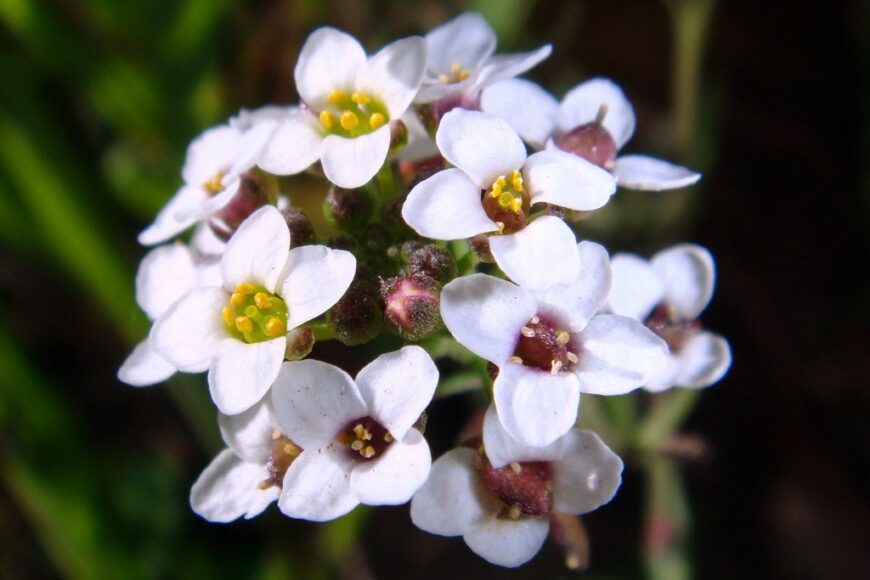
 Name: Official name: Lobularia maritima, Alternative names: Sweet alison, Basket of gold, Honey flower, Madonna's tears
Name: Official name: Lobularia maritima, Alternative names: Sweet alison, Basket of gold, Honey flower, Madonna's tears Family: Brassicaceae
Family: Brassicaceae Origins: Native to the Mediterranean region and parts of Europe, sweet alyssum has been cultivated for centuries as an ornamental plant.
Origins: Native to the Mediterranean region and parts of Europe, sweet alyssum has been cultivated for centuries as an ornamental plant.  Humidity: Sweet alyssum prefers moderate humidity levels. It can tolerate drier conditions, but it will do best in areas with some humidity.
Humidity: Sweet alyssum prefers moderate humidity levels. It can tolerate drier conditions, but it will do best in areas with some humidity. Location: Sweet alyssum thrives in full sun to partial shade. It is a versatile plant that can be grown in borders, rock gardens, containers, and even as a groundcover.
Location: Sweet alyssum thrives in full sun to partial shade. It is a versatile plant that can be grown in borders, rock gardens, containers, and even as a groundcover. Soil: Sweet alyssum prefers well-drained, fertile soil. It is not too picky about soil pH, but it prefers a slightly alkaline soil.
Soil: Sweet alyssum prefers well-drained, fertile soil. It is not too picky about soil pH, but it prefers a slightly alkaline soil. Pests and diseases: Sweet alyssum is relatively resistant to pests and diseases. However, it can be susceptible to aphids, flea beetles, and powdery mildew.
Pests and diseases: Sweet alyssum is relatively resistant to pests and diseases. However, it can be susceptible to aphids, flea beetles, and powdery mildew. Care: Sweet alyssum is a low-maintenance plant. It requires regular watering, especially during dry periods. It also benefits from a light application of fertilizer every few weeks.
Care: Sweet alyssum is a low-maintenance plant. It requires regular watering, especially during dry periods. It also benefits from a light application of fertilizer every few weeks. Height of growth: Sweet alyssum is a low-growing plant that typically reaches 6 to 12 inches tall and spreads 8 to 12 inches wide.
Height of growth: Sweet alyssum is a low-growing plant that typically reaches 6 to 12 inches tall and spreads 8 to 12 inches wide. Planting in the soil: Sweet alyssum can be planted in the soil in the spring or fall. Sow seeds indoors 6 to 8 weeks before the last frost date. Transplant seedlings outdoors after the last frost has passed.
Planting in the soil: Sweet alyssum can be planted in the soil in the spring or fall. Sow seeds indoors 6 to 8 weeks before the last frost date. Transplant seedlings outdoors after the last frost has passed. Blooming: Sweet alyssum blooms from spring to fall. The flowers are small and fragrant, and they come in a variety of colors, including white, purple, pink, and lavender.
Blooming: Sweet alyssum blooms from spring to fall. The flowers are small and fragrant, and they come in a variety of colors, including white, purple, pink, and lavender.Welcome to the enchanting world of Sweet Alyssum (Lobularia maritima), a petite yet captivating flowering plant. As a seasoned botanist with two decades of experience, I am thrilled to guide you through the intricacies of planting and caring for this delightful species.
Unveiling Sweet Alyssum
Sweet Alyssum, belonging to the Brassicaceae family, is renowned for its dainty clusters of fragrant flowers. Originating from the Mediterranean region, these annuals or perennials have found homes in gardens worldwide.
Planting Sweet Alyssum
Ideal Growing Conditions
To unleash the full charm of Sweet Alyssum, provide well-drained soil and ample sunlight. These plants thrive in USDA hardiness zones 4-9, making them adaptable to various climates.
Propagation Techniques
Seeds:
- Sow seeds directly in the garden after the last frost, as Sweet Alyssum is cold-tolerant.
- Gently press seeds into the soil, ensuring good seed-to-soil contact.
- Keep the soil consistently moist until seedlings emerge.
Transplants:
- For an early start, begin seeds indoors 6-8 weeks before the last expected frost.
- Transplant seedlings outdoors once they have developed a sturdy root system.
Caring for Sweet Alyssum
Watering
Sweet Alyssum prefers moderate watering. Keep the soil consistently moist but avoid waterlogging, as these plants are susceptible to root rot.
Fertilization
Alyssum is not overly demanding when it comes to fertilization. A balanced, all-purpose fertilizer applied in spring is usually sufficient.
Pruning
Regular deadheading promotes continuous blooming, enhancing the longevity of the floral display. Trim spent flowers to encourage new growth.
Applications and Benefits
Garden Borders and Containers
Sweet Alyssum is a charming addition to garden borders and containers. Its low-growing habit makes it an ideal choice for edging, creating a fragrant frame for other garden inhabitants.
Companion Planting
Harness the power of companion planting by placing Sweet Alyssum near vegetables like tomatoes and brassicas. It attracts beneficial insects, contributing to natural pest control.
Medicinal Uses
While primarily ornamental, Sweet Alyssum has been traditionally used in herbal medicine for its mild analgesic properties. Research suggests potential applications in topical formulations.
FAQ
Q: Is Sweet Alyssum deer-resistant?
A: Yes, Sweet Alyssum is generally deer-resistant due to its fragrant nature.
Q: Can I grow Sweet Alyssum indoors?
A: While it prefers outdoor conditions, Sweet Alyssum can be grown indoors if provided with ample sunlight.
Q: How do I combat aphids on Sweet Alyssum?
A: Introduce natural predators like ladybugs or use a gentle insecticidal soap to control aphid infestations.

